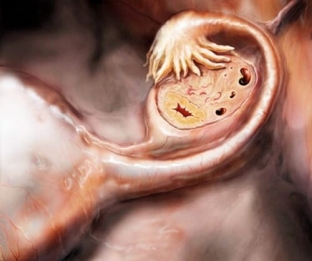Ovarian exhaustion syndrome is a pathological condition of a woman's body, clinically very reminiscent of the onset of menopause. Ovarian wasting is a genetically determined disease that develops predominantly in women younger than 40 years of age, with no reproductive or menstrual dysfunction in the past. Clinically, ovarian depletion is manifested by the development of secondary amenorrhea, infertility, and signs of vegetative-vascular disorders. Ovarian syndrome occurs in 1.5% of all women, and in 10% of cases this disease is the cause of secondary amenorrhea and infertility.
Causes of ovarian failure syndrome
Chromosomal abnormalities and autoimmune disorders are the main causes of ovarian failure syndrome. Almost 50% of women with this diagnosis have a family history of gynecology, there have been cases of infertility in blood relatives. In this disease, healthy ovarian tissue is replaced by connective tissue. But only a defective genome is not enough to start this process. Therefore, it is customary to single out the following factors that predispose to the development of emaciated ovary syndrome:
- infectious diseases;
- frequent stressful conditions;
- radiation effects;
- drug toxicity;
- hypo- and avitaminosis;
- long fasting;
- pathologies of intrauterine development: extragenital pathology and toxicosis in the mother.
Clinical presentation of emaciated ovary syndrome: main manifestations
The first symptom of ovarian exhaustion is the spontaneous occurrence of secondary amenorrhea, or oligomenorrhea, with the gradual onset of persistent amenorrhea in women of reproductive age, as well as the development of infertility. Characteristic is the absence of violations of menstruation and reproductive function in the past, as well as the normal appearance of the patient: the correct physique, the absence of obesity. Subsequently, symptoms resembling the clinical picture of menopause join: increased weakness, headaches, disability, sweating and periodic "hot flashes". In parallel with this, atrophic processes develop in the genitals and mammary glands.
Instrumental and laboratory methods for diagnosing ovarian failure syndrome
A detailed medical history is the first step for a gynecologist when a woman contacts him with complaints of amenorrhea or oligomenorrhea or infertility. For exhausted ovary syndrome, a characteristic feature is secondary amenorrhea, which means that the menstrual and reproductive functions of a woman have not been disturbed over the past 10-15 years. Functional diagnostic methods will indicate the absence of ovulation. A characteristic laboratory finding is a significant increase in the concentrations of follicle-stimulating and luteinizing hormones, while the level of prostaglandin E2 will be virtually the same as in young women who have undergone oophorectomy.

With the help of ultrasound, the uterus and ovaries are significantly reduced in size, which indicates their atrophy. With the help of diagnostic laparoscopy, small, "wrinkled" ovaries can be seen, in which the follicles are not visible, and there is no corpus luteum. An ovarian biopsy confirms the absence of a follicular apparatus.
Methods of treatment of ovarian failure syndrome
Treatment of ovarian failure is more symptomatic and aims to improve the general condition of the woman. Unfortunately, infertility in this case is irreversible, and it is not possible to restore the natural reproductive function with such a diagnosis. Pregnancy with ovarian failure can only be achieved through in vitro fertilization using a donor egg. Patients with ovarian failure syndrome are shown to be prescribed hormone replacement therapy before the onset of age-related menopause, in order to prevent the occurrence of serious metabolic disorders. Estrogen-gestagenic preparations are used in individually selected combinations and dosages. This therapy helps to eliminate menopausal symptoms,








Add a comment